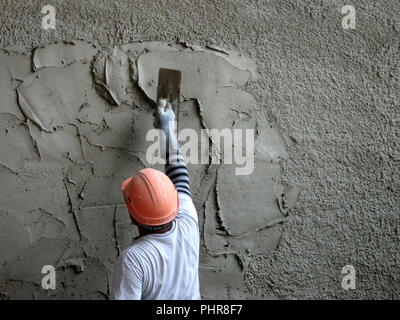Professional Tips for Perfect Plastering: Achieve a Flawless End Up Every Time
Wiki Article
Key Tips and Tools for Effective Plastering in Your Home Renovation Endeavors
Attaining a flawless plaster coating in your home enhancement projects needs a mix of the right devices and tried and tested methods. Recognizing the subtleties of blending plaster and using it in slim layers can dramatically influence the final outcome.Necessary Smudging Tools
A plasterer's toolkit is essential to achieving a smooth and resilient finish on walls and ceilings. The essential tools encompass a selection of applies made to promote the smudging procedure successfully and properly. Trick parts consist of a hawk, which is a flat, square tool utilized to hold the plaster while applying it to surfaces. This device permits for simple transport and application of the product.
Furthermore, a mixing pail is needed for preparing plaster, ensuring the appropriate uniformity before application. A gluing brush or sponge is valuable for ending up touches and smoothing out structures. Lastly, safety devices such as handwear covers and masks should be included to safeguard the individual from dirt and chemicals. Together, these vital plastering tools enable both specialists and do it yourself lovers to attain high-grade cause their smudging projects.
Surface Prep Work Strategies
Correctly preparing the surface prior to smudging is critical for ensuring adhesion and accomplishing a remarkable finish. The primary step entails cleansing the surface area to eliminate any dust, grease, or old paint that might impede the plaster's capacity to bond effectively. A complete clean with a suitable cleaning service is suggested, complied with by washing and allowing the surface to completely dry totally.Next, evaluate the surface area for any type of flaws or splits. These must be loaded with an appropriate filler compound and permitted to heal according to the maker's instructions. For porous surface areas, applying a guide is necessary to improve and create a consistent structure attachment.
In addition, it is essential to make sure that the surface is stable and structurally audio. Any type of loose products, such as flaking paint or damaged drywall, need to be repaired or removed. Think about using a scratch layer to improve hold. if functioning with stonework surface areas.
Mixing Plaster Like a Pro

Making use of a clean mixing container, pour the water initially, after that gradually include the plaster powder while mixing continuously. This technique aids to avoid clumping and ensures an also distribution of products.
Once combined, permit the plaster to relax for a few mins to allow the plaster crystals to moisturize completely. This pause boosts workability and reduces the risk of splitting throughout application. By adhering to these actions, you can blend plaster like a professional, setting the foundation for an effective plastering job in your house improvement undertakings.
Application Methods for Smooth Finishes
With the plaster mix prepared to the suitable uniformity, the next step entails picking proper application techniques to accomplish a smooth finish. This device enables for a fine, even circulation of plaster throughout the surface area while lessening trowel marks.Begin by applying a generous amount of plaster to the surface area making use of the trowel, ensuring it adheres well. Employ a methodical method, working from the lower upward. Once the first layer is applied, make use of a sweeping movement to smooth the surface, using also pressure. In areas that require even more meticulous attention, take into consideration using a float, which can assist get rid of any type of imperfections and create a consistent appearance.
For the last touches, a moist sponge can be utilized to improve the surface better. Lightly haze the plaster with water and gently scrub the surface area to accomplish a sleek impact. Constantly keep in mind to operate in little sections to preserve control over the application procedure, ensuring a smooth, specialist surface throughout your plastering task.
Usual Errors to Stay Clear Of
When other embarking on a gluing task, staying clear of common blunders is important for achieving a perfect coating. Guarantee that all dirt, oil, and loosened materials are browse around this site removed before using plaster.Another typical mistake is using plaster too thickly. Thick layers can crack as they dry out, endangering the integrity of the finish. Instead, go with several slim layers, enabling each layer to dry totally prior to using the following.
Additionally, inadequate mixing strategies can lead to irregular texture and workability. Always adhere to the supplier's guidelines for blending proportions and extensively mix the plaster to accomplish an uniform uniformity.

Timing also plays a vital duty; plaster must be used while the substratum is moist to enhance adhesion. Premium trowels and floats can make a significant difference in attaining a smooth finish.
Conclusion
Reliable plastering needs a thorough understanding of essential tools and strategies. By making use of correct devices, guaranteeing careful surface area preparation, and sticking to suggested blending proportions, optimal outcomes can be achieved. Using appropriate application approaches better improves the finish, while understanding of common mistakes can avoid obstacles. Proficiency of these components not just contributes to the aesthetic appeal of a room yet additionally makes sure durability and durability in gluing jobs, making them indispensable to effective home enhancement undertakings.A float is another essential device, which aids in leveling the plaster and attaining a consistent surface area.

By following these steps, you can blend plaster like a pro, setting the foundation for a successful gluing project in your home enhancement endeavors.
Gently haze the plaster with water and gently rub the surface area to accomplish a refined result.
Report this wiki page